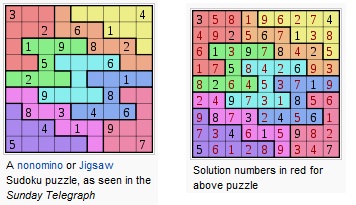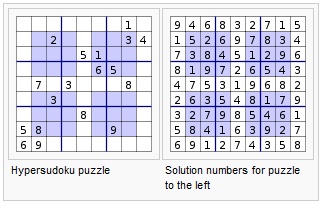Variants of Sudoku
Although the 9x9 grid with 3x3 regions is by far the most common, many variations exist. Sample puzzles can be 4x4 grids with 2x2 regions; 5x5 grids with pentomino regions have been published under the name Logi-5; the World Puzzle Championship has featured a 6x6 grid with 2x3 regions and a 7x7 grid with six heptomino regions and a disjoint region. Larger grids are also possible. The Times offers a 12x12-grid Dodeka sudoku with 12 regions of 4x3 squares. Dell regularly publishes 16x16 Number Place Challenger puzzles (the 16x16 variant often uses 1 through G rather than the 0 through F used in hexadecimal). Nikoli offers 25x25 Sudoku the Giant behemoths. Sudoku-zilla, a 100x100-grid was published in print in 2010.
Another common variant is to add limits on the placement of numbers beyond the usual row, column, and box requirements. Often the limit takes the form of an extra "dimension"; the most common is to require the numbers in the main diagonals of the grid also to be unique. The aforementioned Number Place Challenger puzzles are all of this variant, as are the Sudoku X puzzles in the Daily Mail, which use 6x6 grids. The Sudoku X4 family of iPhone/iPad apps combine this "X" varation with the Sunday Telegraph-style interlocking colored nonomino or Jigsaw shapes of nine spaces each instead of the 3x3 regions, providing a total of four different kinds of puzzles.

Mini Sudoku
A variant named "Mini Sudoku" appears in the American newspaper USA Today and elsewhere, which is
played on a 6x6 grid with 3x2 regions. The object is the same as standard Sudoku, but the puzzle only uses the numbers 1 through 6. A similar form, for younger solvers of puzzles, called "The Junior Sudoku", has appeared in some newspapers, such as some editions of The Daily Mail.
Cross Sums Sudoku
Another variant is the combination of Sudoku with Kakuro on a 9x9 grid, called Cross Sums Sudoku, in which clues are given in terms of cross sums. The clues can also be given by cryptic alphametics in which each letter represents a single digit from 0 to 9. An example is NUMBER+NUMBER=KAKURO which has a unique solution 186925+186925=373850. Another example is SUDOKU=ISxFUNNY whose solution is 426972=34x12558.
Killer Sudoku
The Killer Sudoku variant combines elements of Sudoku and Kakuro.
Alphabetical Sudoku
Alphabetical variations have emerged, sometimes called Wordoku; there is no functional difference in the puzzle unless the letters spell something. Some variants, such as in the TV Guide, include a word reading along a main diagonal, row, or column once solved; determining the word in advance can be viewed as a solving aid. A Wordoku might contain other words, other than the main word.
Hypersudoku

Hypersudoku is one of the most popular variants. It is published by newspapers and magazines around the world and is also known as "NRC Sudoku," "Windoku," "Hyper-Sudoku" and "4 Square Sudoku." The layout is identical to a normal Sudoku, but with additional interior areas defined in which the numbers 1 to 9 must appear. The solving algorithm is slightly different from the normal Sudoku puzzles because of the leverage on the overlapping squares. This overlap gives the player more information to logically reduce the possibilities in the remaining squares. The approach to playing is similar to Sudoku but with possibly more emphasis on scanning the squares and overlap rather than columns and rows
Duidoku
Duidoku is a two player variant of Sudoku. It is played on a 4x4 board i.e 16 squares or four clusters each containing four squares.
The game is followed using the rules of Sudoku. Four numbers are used,and each player consecutively places one number out of the four such that he or she makes no illegal moves. The first player to make an illegal move loses.
